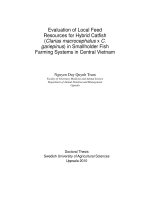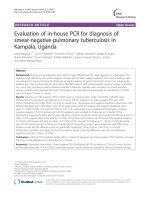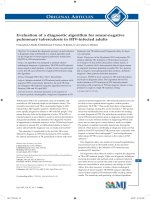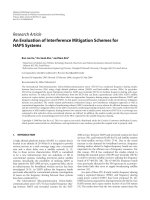Evaluation of height equivalent theoretical plate of packing distillation column for benzaldehyde purification processing
Bạn đang xem bản rút gọn của tài liệu. Xem và tải ngay bản đầy đủ của tài liệu tại đây (715.87 KB, 8 trang )
JST: Engineering and Technology for Sustainable Development
Volume 32, Issue 4, October 2022, 017-024
Evaluation of Height Equivalent Theoretical Plate of Packing Distillation
Column for Benzaldehyde Purification Processing
Nguyen Trung Dung, Phan Ngoc Quang, Pham Duc Anh, Do Nguyen Ha Thu,
Nguyen Van Anh, Ta Hong Duc, Cao Hong Ha*
School of Chemical Engineering, Hanoi University of Science and Technology, Hanoi, Vietnam
*
Corresponding author email:
Abstract
This study analyzes the literature review of the techniques for estimating Height Equivalent Theoretical Plate
(HETP) values for various packing structure models, ranging from theoretical to semi-empirical to shortcut
methods. Packing structures of various meshes and shapes were studied on the purification of benzaldehyde
from the mixture of benzaldehyde and cinnamaldehyde. The packing structures M-50, M-80, O-80, and S-80
were estimated using Fenske’s approach as 0.052, 0.053, 0.045, and 0.056, respectively. Experiment data
and simulation result obtained by commercial software were utilized to validate the packing's HETP value.
A pilot of the vacuum batch distillation system was fabricated including a column filled with packing structures.
The results indicated that the HETP value between experiment and simulation is within 0.6 percent deviation.
On the pilot scale, the results of the benzaldehyde purifying were validated in a batch distillation system with
the O-80 packing structure. This system will be developed for the larger scale, and it will practical.
Keywords: Natural benzaldehyde synthesis, HETP evaluation, batch distillation, random packing, simulation
1. Introduction
complete, and the reaction system contained a number
of undesired side reactions, resulting in a poor yield
of natural benzaldehyde. Purification of benzaldehyde
following green synthesis from cinnamaldehyde is
also a challenge. The conversion efficiency of
cinnamaldehyde to benzaldehyde is around
40-50 percent, according to the results of the study [1].
Purification of benzaldehyde to a purity of 99 wt. % is
generally done in a vacuum distillation unit once the
reaction is finished.
Among the aldehyde compounds used as aroma
compositions for the cosmetic, pharmaceutical, and
food industries, benzaldehyde is one of the most
important aldehydes used in flavoring additives.
Benzaldehyde is known as the almond aroma, this
compound is used as a flavor ingredient in biscuits,
butter, cheese, etc. In industry, benzaldehyde can be
synthesized, extracted from natural fruits (e.g.,
almond, cherry...) or distilled and converted from
cinnamon essential oil.
*
In the chemical industry, the distillation process
is widely employed. It refers to the process of
purifying a mixture containing components with
various boiling points. The advantages of the packing
column are low pressure drop, great mass transfer
efficiency, and high capacity. It's especially wellsuited to vacuum fractionation applications. The
performance of packed columns, for distillation or
absorption services, are frequently expressed in terms
of Height Equivalent to a Theoretical Plate (HETP)
or/and Height of Transfer Unit (HTU). For packed
columns, a variety of empirical or semi-theoretical
mass-transfer models have been reported in the
literature. There are several models in the literature
that use equations or graphs to estimate pressure drop
and capacity. On the other hand, some models are
based on the two-film theory and penetration theory.
Bravo et al. [6] developed the most commonly used
model for calculating the HETP or HTU for structured
packing, known as the BRF model. The authors
assumed that the liquid-side mass transfer resistance
Many studies have established and suggested
various techniques for manufacturing, such as
ozonization, near-critical water hydrolysis, toxic phase
transfer, and surfactant catalytic processes. To explore
and optimize the process of natural benzaldehyde
synthesis from cinnamaldehyde, Patrick et al. [1]
evaluated three methods. The first route is based on
Buck's (1987) patent [2], the second route is based on
Wright's (1993) research [3], and the third route is
based on Yang's (2012, 2013) study [4,5]. The first
approach used a high-pH reaction that was simple to
set up and observe. This technique, however, may
reduce the natural essence of benzaldehyde (high pH
condition). Because of the difficult reaction conditions
with a powerful oxidant, the second method proved
more difficult to manage. The final approach allowed
for trans-cinnamaldehyde to be converted to
benzaldehyde using a heterogeneous catalytic
technique. This technique took a long time to
ISSN 2734-9381
/>Received: January 26, 2022; accepted: May 7, 2022
17
JST: Engineering and Technology for Sustainable Development
Volume 32, Issue 4, October 2022, 017-024
H. Z. Kister, 1992 [10] corrected of Harrison
correlation for conservation by equation:
100
𝐻𝐻𝐻𝐻𝐻𝐻𝐻𝐻 =
+ 0.102
(4)
𝑎𝑎𝑝𝑝
could be ignored, and that HETP could be
approximated to the gas-side mass transfer resistance.
Bravo et al. [7] proposed a new version of the previous
equations called the SRP (Separations Research
Program) model. The authors modified the previous
assumption about complete wettability of the packing
surface area. The SRP model included two corrective
factors to predict the effective surface area. The first
parameter is the surface enhancement factor (FSE)
which accounts for variations of surface packing and
the second is a correction factor for total liquid holdup due to effective wetted area (Ft). By using
31 distinct liquid-gas systems and 67 different types of
packings, Billet and Schultes, 1993 [8] investigated the
mass transfer process into packed columns for gas
absorption and distillation operations (BS model). The
authors investigated different height and diameter
columns, operating in a counter-current flow with both
structured and random packings in this research. The
penetration hypothesis was also used to both gas and
liquid mass transfer. The mass transfer model in the
gas phase is based on the assumption that gas flows in
various directions through the packing and that the
contact area between phases must be refreshed after a
theoretical time (tG). The packing specific constants,
CLBS and CGBS, are dependent on the specific
structures and material of the packing.
Carillo et al., (2000) [11] improved and extended
Lockett's equation for vacuum or pressure distillation
of organic or aqueous systems in columns of sheet
packings by:
5.40𝑔𝑔0.5 (𝜌𝜌𝐿𝐿 )0.5
𝐻𝐻𝐻𝐻𝐻𝐻𝐻𝐻 =
𝜌𝜌𝑔𝑔 0.25 2
𝑎𝑎𝑝𝑝 �1 + 0.78 𝑒𝑒𝑒𝑒𝑒𝑒�0.00058 𝑎𝑎𝑝𝑝 � � � �
𝜌𝜌𝐿𝐿
(5)
From the experimental results, the HETP can
estimated by equation:
𝐻𝐻𝐻𝐻𝐻𝐻𝐻𝐻 =
For a binary mixture with constant relative
volatility and constant molar overflow, the Fenske
equation could be used to compute the number of
theoretical stages required to achieve the desired
separation.
𝑥𝑥 /(1 − 𝑥𝑥𝐷𝐷 )
𝑙𝑙𝑙𝑙 𝐷𝐷
(1 − 𝑥𝑥𝑤𝑤 )/𝑥𝑥𝑤𝑤
(7)
𝑁𝑁𝑁𝑁𝑁𝑁 =
𝑙𝑙𝑙𝑙 𝛼𝛼𝑚𝑚
where 𝛼𝛼𝑚𝑚 is the relative volatility of the mixture, and
xd and xw are the compositions of the top and bottom of
the column.
Bessou et al., 2010 [12] modified the Fenske
equation for packing distillation by equation:
𝑥𝑥𝑛𝑛−1 − 𝑥𝑥𝑤𝑤
𝑁𝑁𝑁𝑁𝑁𝑁 = (𝑛𝑛 − 1) + �
�
(8)
𝑥𝑥𝑛𝑛−1 − 𝑥𝑥𝑛𝑛
100
(1)
𝑎𝑎𝑝𝑝
where: ap - packing specific interfacial area [m-1]
𝐻𝐻𝐻𝐻𝐻𝐻𝐻𝐻 =
where xn is liquid molar fraction of stage number n.
In this paper, the various experimental results
were carried out on a batch distillation pilot size to
characterize the various packing configurations. The
HETP of a packed column must be computed for each
packing type. The best packing configuration will be
used to purify benzaldehyde from the reaction mixture
and the results also will be compared to simulated
results using commercial software.
For atmospheric distillation, Intalox structured
packing, Strigle et al., (1994) [9] proposed equation:
(2)
where: 𝜎𝜎𝐿𝐿 - surface tension [N/m] and 𝜇𝜇𝐿𝐿 - viscosity
[Pa.s]
Based on BRF model, good accuracy for
estimating the basic HETP of Flexipac packing with
organic system, Lockett et al., [9] proposed an
equation:
𝐻𝐻𝐻𝐻𝐻𝐻𝐻𝐻 =
1.54𝑔𝑔0.5 �𝜌𝜌𝐿𝐿 − 𝜌𝜌𝑔𝑔 �
2. Experiments
2.1. Packing Distillation Structures
The material for fabricating difference types of
packing was SUS-304 stainless steel mesh (50 and 80
mesh corresponding with packing type: M-50, M-80,
S-80, and O-80) with technical parameters shown in
Table 1. Packings were cut and shaped by hand. The
shapes of the different packings with the average
dimensions were shown in Fig.1.
0.5 0.06
𝜇𝜇
𝑎𝑎𝑝𝑝 �1 + 0.78 𝑒𝑒𝑒𝑒𝑒𝑒�0.00058 𝑎𝑎𝑝𝑝 � �
(6)
where NTS - number of theoretical stages; H - packing
height
Short-cut methods, unlike rigorous models, could
successfully provide a rapid evaluation of a separation
possibility for initial tests and thus have been widely
used by chemical engineers. G. Q. Wang et al., 2005
[9] provided a summary of shortcut models available
in the recent open literature for predicting the HETP of
a packed column. For structured packing with a crimp
angle of 45o and troubleshooting purposes, Harrison et
al., (1989) suggestion an equation:
𝐻𝐻𝐻𝐻𝐻𝐻𝐻𝐻 = 𝑒𝑒𝑒𝑒𝑒𝑒(𝑛𝑛 − 0.187 𝑙𝑙𝑙𝑙 𝜎𝜎𝐿𝐿 + 0.213 𝑙𝑙𝑙𝑙 𝜇𝜇𝐿𝐿 )
𝐻𝐻
𝑁𝑁𝑁𝑁𝑁𝑁
𝜌𝜌𝑔𝑔 0.25 2
� �
𝜌𝜌𝐿𝐿
(3)
where: 𝑔𝑔 - gravitational constant [m/s2], 𝜌𝜌 - density
[kg/m3].
18
JST: Engineering and Technology for Sustainable Development
Volume 32, Issue 4, October 2022, 017-024
Table 1. Technical data of packaging materials
Stainless steel mesh
SUS 304, 50 mesh
0.2286
0.2794
30
0.4572
~ 267.99
Wire diameter (mm)
Opening (mm)
Opening (%)
Overall thickness (mm)
Density (g/m2)
Stainless steel mesh
SUS 304, 80 mesh
0.1397
0.1778
31
0.2794
~ 235.83
Fig. 1. Various geometric parameters of the packings.
2.2. Experimental Setup and Methods
that was set right above the top of the packing in the
column.
The experiment setup was shown in Fig. 2. The
experiment system consists of a still (250 mL round
bottom flask) that was heated by a heating mantle for
round flasks. Two thermometers were set up at the
bottom and the top of the distillation system. A
condenser was cooled by water refrigerant. A distillate
van and reflux van were designed to control the reflux
ratio during the distillation process. The column was
isolated by glass wool jacket.
The concentration of n-hexane and cyclohexane
were measured by the refractometer Abbe Mark III,
Reichert, USA. The cinnamaldehyde distillated
from cinnamomum cassia oil (99.0%, purchased
from Arenex Co. Ltd. Viet Nam) and benzaldehyde
(99.0 wt. %, purchased from Arenex Co. Ltd. Viet
Nam) content of the top products and bottom products
were determined by Gas Chromatography (GC)
method using the SHIMAZU GC-2010 plus (FID
detector) system. The chemicals used were as follows:
n-hexane 99%, GHTECH, China (CAS 110-54-3) and
Cyclohexane 99.7%, GHTECH, China (CAS 110-827). The experiments were performed in a laboratory
batch distillation column made from a glass tube with
40 mm of inner diameter and 550 mm long. The
column was filled with the shaped random packings.
This column was designed with a liquid dispenser part
Fig. 2. Experimental setup for HETP evaluation:
1. Heating mantle for round flasks; 2. Still (250 mL
round bottom flask); 3 and 5. Thermometer; 4. Column
with shaped random packings; 6. Condenser;
7. Vacuum pump; 8. Vale; 9. Liquid separation
container.
19
JST: Engineering and Technology for Sustainable Development
Volume 32, Issue 4, October 2022, 017-024
3. Result and Discussion
The bottom mixture was heated by a heating
mantle to boiling point, after which the refrigerant
fully condenses the vapor at the top of the column. The
temperature of the reboiler and the top of the
column were
measured
using
thermometers.
In this study, the HETP index of the packing was
measured based on an n-Hexane/Cyclohexane
mixture. This mixture was normally used as an ideal
mixture for characterizing the HETP of packing, [12].
One of the major reasons was the high relative
volatility of the two components. At atmospheric
pressure (101 kPa), the experiments were carried out
with a prepared n-Hexane/Cyclohexane mixture. A
100 mL of mixture of the n-Hexane/Cyclohexane with
volume ratio (V1:V2) was prepared for distilling. This
mixture was loaded into the reboiler and heated by
heating mantle. When the liquid-vapour equilibrium in
the system was stable in about 1 hour, the liquid
samples at the top and bottom of the column were
collected and analyzed by refractometry. The time
between the first vapor release and the first sample was
almost 60 minutes, and a steady state was considered
to be achieved when three successive samples had
identical compositions. The mole fraction at both the
top and bottom were used to calculate the number of
theoretical stages (NTS). The mass transfer was
reported in terms of the height equivalent of a
theoretical plate (HETP). Three cases researches were
performed for each packing type, with the following
initial volume compositions: n-hexane (mL):
cyclohexane (mL) = V1:V2 = 30:70; 50:50; and 70:30.
3.2. HETP Evaluation
Consider the distillation of cyclohexane/nhexane at 101 kPa at total reflux, Fig. 4 shows the
relative volatility (αavg) with composition for this
system calculated using NRTL models by AspenPlus®
software (Version 10) to estimate constant relative
volatilities. This calculation was based on the vapor
and liquid mole fraction of n-hexane and cyclohexane.
The volatility of the components can be determined by
(9):
𝑦𝑦𝑖𝑖
𝐾𝐾𝑖𝑖 =
(9)
𝑥𝑥𝑖𝑖
where xi - liquid mole fraction and yi - vapor mole
fraction; i = 1 to n; n - number of simulated data.
Based on the simulated results, we can estimate
the average relative volatility of the mixture by (10):
𝛼𝛼𝑎𝑎𝑎𝑎𝑎𝑎 =
∑𝑛𝑛1
𝐾𝐾𝑛𝑛−ℎ𝑒𝑒𝑒𝑒𝑒𝑒𝑒𝑒𝑒𝑒
𝐾𝐾𝑐𝑐𝑐𝑐𝑐𝑐𝑐𝑐𝑐𝑐ℎ𝑒𝑒𝑒𝑒𝑒𝑒𝑒𝑒𝑒𝑒
= 1.477
𝑛𝑛
(10)
where: αavg - Relative volatility of n-hexane and
cyclohexane; Kn-hexane - Volatility of n-hexane;
Kcyclohexane - Volatility of cyclohexane; n - number of
simulated data.
Different volume fractions and construction
types of packing were used in the laboratory
distillation column. The compositions of the top and
bottom liquids were determined by calibration curve of
the mole fraction of the n-hexane/cyclohexane mixture
and the refractive index, Fig 3. The Fenske equation
was used to evaluate various HETP values for a part of
the column, as shown in Table 2. These results were
also the relationship between the input mixture
composition and HETP index. The values of relative
volatility and geometrics of the packing types effected
to HETP values. Therefore, in the process design and
the simulation, the average HETP was assumed to be
constant in the distillation column.
2.3. Calibration Curve
In order to analyze the mixture of n-hexane and
cyclohexane, a calibration curve of the mole fraction
of the n-hexane/cyclohexane mixture and the
refractive index was built, Fig. 3. These samples were
prepared by mixing and measured by using a
refractometer at ambient conditions. Fig. 3 shows that
the correlation coefficient between model and
experimental values was acceptable with R2 = 0.998.
Interpolating from the graph yields the composition of
the distillate and bottom products.
Fig. 3. Calibration curve for mole fraction of n-hexane
with RI.
Fig. 4. K-value for cyclohexane/n-hexane
20
JST: Engineering and Technology for Sustainable Development
Volume 32, Issue 4, October 2022, 017-024
Table 2. HETPm evaluations
M-50
M-80
O-80
S-80
V1/V2
30/70 50/50
(mL/mL)
70/30
30/70
50/50
70/30
30/70
50/50
70/30
30/70
50/50
70/30
xF
0.263 0.450
(% mole)
0.660
0.263
0.45
0.660
0.263
0.45
0.660
0.263
0.45
0.660
1.390 1.384
1.384
1.391
1.378
1.384
1.383
1.383
1.380
1.379
1.384
1.389
xD
0.572 0.705
(% mole)
0.705
0.566
0.87
0.714
0.731
0.743
0.814
0.811
0.698
0.589
1.421 1.415
1.414
1.421
1.408
1.411
1.42
1.421
1.405
1.415
1.409
1.417
xW
0.046 0.137
(% mole)
0.148
0.045
0.25
0.205
0.06
0.045
0.29
0.121
0.219
0.092
RID
RIW
NTS
8.987 7.336
7.092
8.984
8.115
6.142
10.15
11.14
6.416
9.305
5.706
7.167
HETP
(m-1)
0.045 0.055
0.056
0.045
0.049
0.065
0.039
0.036
0.062
0.043
0.070
0.056
HETPm
(m-1)
0.052
0.053
0.045
According to experimental data, the HETP values
were not significant changed when the mesh size
increases from type M-50 to type M-80. These results
could be explained that the opening (%) of the two
materials were the same (~ 30 %). However, with
various geometrics of the packing, like M, O, and
S geometrics, HETP values were changed due to
specific packing interfacial area and void fraction as
the packing parameters, as they are the most important
factors affecting mass transfer for structural packings.
Table 2 shows results of the HETP calculation, and the
excellent HETP was obtained by the packing with
O geometric (HETPm = 0.045 m-1). By using these
results shown in Table 2, the average of the number of
theoretical stages of the packing in the experiments
could be calculated, NTS = 9.23.
0.056
and the temperature of the top column were measured.
The distillate composition shown in Table 3
and Fig. 8 including benzaldehyde 99.3 wt. % and
cinnamaldehyde 0.7 wt. % In the commercial
simulation software, Fig. 5 illustrates a simulation
model of the batch distillation process. The number of
stages was set at 9 based on the estimated HETP data
for the O-80 packing configuration. The simulation
pressure was 50 mmHg of vacuum pressure, which
was the same as the experimental pressure. The
simulation was a total reflux condition. Based on the
work of X. Li et al., (2014) [13], the thermodynamic
model was chosen as the NRTL model.
3.2 Validation of the HETP O-80 Geometric Packing
A mixture of benzaldehyde and cinnamaldehyde
was used in the batch distillation pilot to validate the
HETP result for the O-80 packing structure as shown
in the Table 3. The experimental results were then
compared to simulated results using Aspen plus
software. The still was filled with a mixture was
natural benzaldehyde mixing with cinnamaldehyde
with the ratio 1:1. The mixture was then raised to a
boil. The rising vapor will be condensed and
re-circulated completely. During experiments, the
working pressure was set to 50 mmHg of vacuum
pressure to decrease the decomposition of
benzaldehyde and cinnamaldehyde. After the process
has stabilized, sampling is performed at the condenser
Fig. 5. Batch distillation model in Aspen Plus®
software.
21
JST: Engineering and Technology for Sustainable Development
Volume 32, Issue 4, October 2022, 017-024
Table 3. Comparison between experimental data and simulation results
Experimental data
Initial data:
- Benzaldehyde (g)
- Cinnamaldehyde (g)
- Operation pressure (mmHg)
- Heigh of column (mm)
- Number of stage (NTS)
Result:
- Top temperature (oC)
Distillate composition
- Benzaldehyde (wt. %)
- Cinnamaldehyde (wt. %)
(*)
Simulate results
Error, %
25.0
25.0
50.0
550.0
9.23(*)
25.0
25.0
50.0
9
91.5
94.3
3.06
99.3
0.7
99.9
0.1
0.60
calculated by the heigh of column (mm)/HETP
Fig. 6. Liquid fraction mass profile in batch
distillation.
Fig. 7. Temperature profile in batch distillation.
Fig. 6 and 7 show the mass fraction composition
and the temperature profiles in the batch distillation.
As shown in Fig. 6, the simulation results showed that
the composition of benzaldehyde increases from the 9th
stage (bottom stage) to the 1st stage (condenser stage),
and the composition of cinnamaldehyde decreases. It
means that the cinnamaldehyde component was
located mainly at the bottom and the benzaldehyde
component was located mainly at the top of the
column.
benzaldehyde concentration of 99.9 wt.% in
simulation results. The difference between
experimental data and simulation findings was 0.6 %.
This study demonstrates that it was feasible to purify
benzaldehyde from the reaction mixture after the
packing distillation with a very high content
(99.3 wt.%). This finding further demonstrates that the
HETP data produced for the O-80 type packing
structure was suitable with experiments and
simulation. After distilling the mixture of
cinnamaldehyde/benzaldehyde in the experimental
batch distillation, the top products of the each feeding
mixture with difference volume compositions:
n-hexane (mL): cyclohexane (mL) = V1:V2 = 30:70;
50:50; and 70:30 were analyzed by GC method to
verify the ability separation of the packing type O-80.
The temperature change of the mixture from the
top of to the bottom of the column was shown in the
Fig. 7. The temperature was 94.34 oC at the top and
158.53 oC at the bottom of column. These temperatures
were the boiling temperature of the two components
benzaldehyde and cinnamaldehyde at a vacuum
pressure of 50 mmHg [14].
Fig. 8 shows the GC analysis results of
the
premixture
composition
(mixture
of
cinnamaldehyde/benzaldehyde), Fig. 8 (a), and the top
products, Fig. 8 (b-d). The data indicated that
benzaldehyde results in 99.3 wt. % of the total mass.
This result also proved the very good separation ability
of the packing structure O-80 type.
Table 3 shows that the temperature difference
between experiment and simulation at the top of
the column was 3.06 %. This can be explained by the
fact that there was a loss of heat during the experiment.
The simulation approach, on the other hand, implies
that heat loss was neglected. Furthermore, based on
experimental data, the composition of benzaldehyde in
the top product was 99.3 wt.%. This value achieved a
22
JST: Engineering and Technology for Sustainable Development
Volume 32, Issue 4, October 2022, 017-024
Fig. 8. The GC diagrams of the mixtures in absolute ethanol before and after carrying out the distillation by the
batch distillation pilot. (a) The initial mixture of cinnamaldehyde and benzaldehyde; (b - d) Top products of the
feeding mixture with different volume compositions: Benzaldehyde (mL): Cinnamaldehyde (mL) =
V1:V2 = 30:70, 50:50, and 70:30 of the distillation process.
4. Conclusion
References
This study describes a shortcut technique for
calculating the HETP value for batch distillation
columns. It is employed in the purification of natural
benzaldehyde following green synthesis. The
experiments indicated that the HETP values for the
packing configurations M-50, M-80, O-80, and S-80
are 0.052, 0.053, 0.045, and 0.056, respectively. The
comparison of experimental data and simulation
results with an error of -0.6 percent illustrates that the
short method of estimating HETP is highly reliable,
and that this O-80 structure packing can be used on
a larger scale. Furthermore, the top product
concentration of benzaldehyde is high, up to 99.3 wt.%
The purification of the benzaldehyde process by
vacuum distillation with O-80 packing is very feasible.
[1] Nguyen Trung Dung, Cao Hong Ha, Xuan-Mi Meyer,
Michel Meyer, Jean-Francois Blanco, and Patrick
Cognet, Comparing sustainable methods for synthesis
of natural benzaldehyde from trans-cinnamaldehyde:
Experimental analysis, Vietnam J. Chem., 2020, 58(4),
471-476.
[2] Buck, Keith T., Anthony J. Boeing, and Joseph E.
Dolfini, Method of producing benzaldehyde, U.S.
Patent No. 4,673,766, 16 Jun, 1987.
[3] P. Wright, J. Abbot, The oxidation of cinnamaldehyde
with alkaline hydrogen peroxide, Int. J. Chem. Kinet.,
1993, 25(1), 901-911.
/>[4] Z. J. Yang, H.G. Jiang, X. T. Zhou, Y. X. Fang,
H. B. Ji, β-Cyclodextrin polymer promoted green
synthesis of cinnamaldehyde to natural benzaldehyde in
aqueous solution, Supramol. Chem., 2012, 24(6),
379-384.
/>
Acknowledgments
This research is funded by Hanoi University of
Science and Technology under grant number
T2020-PC-212
[5] Z. Yang, H. Ji. 2-Hydroxypropyl-β-cyclodextrin
polymer as a mimetic enzyme for mediated synthesis of
23
JST: Engineering and Technology for Sustainable Development
Volume 32, Issue 4, October 2022, 017-024
benzaldehyde in water, ACS Sustain. Chem. Eng.,
2013, 1(9), 1172-1179.
/>
[11] Francisco Carrillo, Ana Martin, and Antonio Rosello, A
shortcut method for the estimation of structured
packings HETP in distillation, Chemical Engineering &
Technology, 23, 2000, pp. 425 - 428.
/>
[6] Bravo, J. L., Rocha, J. A., Fair, J. R., Mass transfer in
Gauze Packings, Hydrocarbon Process, 1985, 64, 91-95
[7] Bravo, J. L., Rocha, J. A., Fair, J. R., A comprehensive
model for the performance of columns containing
structured packings, Inst. Chem. Eng. Symp. Ser. 1992,
128, A489-A507.
[12] V. Bessou, D. Rouzineau, M. Prévost, F. Abbé,
C. Dumont, J.-P. Maumus, M. Meyer, Performance
characteristics of a new structured packing. Chemical
Engineering Science, 2010. 65(16): p. 4855-4865.
/>
[8] Billet, R., Schultes, M., Predicting mass transfer in
packed columns, Chem. Eng. Technol. 1993, 16, 1-9.
/>
[13] H. Li, M. Han, X. Gao, X. Li, Isobaric vapor-liquid
equilibrium
for
binary
system
of
cinnamaldehyde+benzaldehyde at 10, 20 and 30kPa,
Fluid Phase Equilibria, 364 (2014) 62-66.
/>
[9] Wang, G. Q., Yuan, X. G., Tang, Z. L., Chen, J. B., &
Yu, K. T., A shortcut method for estimating the HETP
of structured packed distillation columns at elevated
pressure, Chemical Engineering & Technology, 28(7),
767-772. 2005.
/>
[14] C. L. Yaws, M. A. Satyro, Chapter 1 - Vapor Pressure Organic Compounds, in: C. L. Yaws (Ed.) The Yaws
Handbook of Vapor Pressure (Second Edition), Gulf
Professional Publishing, 2015, pp. 1-314.
/>
[10] Henry Z. Kister, Distillation Design, McGraw-Hill,
1992, pp. 523 - 536.
24









